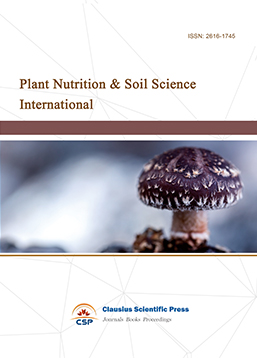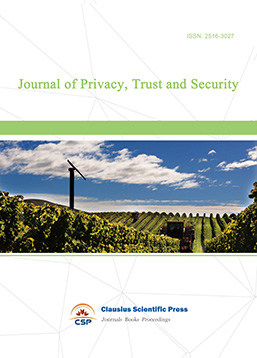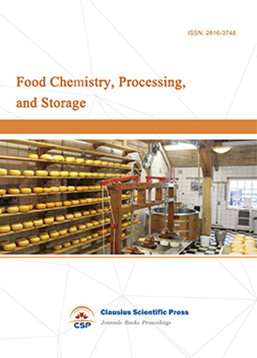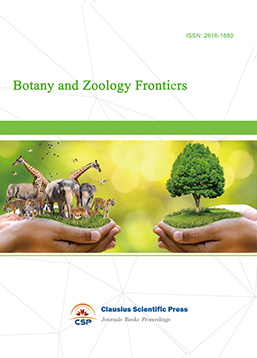Effect of Calcium Cyanamide Treatment Combined with Different Fertilizers on Root-knot Nematode Disease
DOI: 10.23977/afshn.2023.050112 | Downloads: 11 | Views: 258
Author(s)
Botong Wang 1, Jian Wu 1, Shaoke Meng 2, Yongqing Wang 1, Qun Zheng 1, Wenjuan Yan 1, Hanhong Xu 1
Affiliation(s)
1 National Key Laboratory of Green Pesticides/Key Laboratory of Natural Pesticide & Chemical Biology Ministry of Education, South China Agricultural University, Guangzhou, Guangdong, 510642, China
2 Zhongkai College of Agricultural Engineering Resources and Environment, Guangzhou, Guangdong, 510225, China
Corresponding Author
Hanhong XuABSTRACT
The cultivation of chili peppers in Zhanjiang City, Guangdong Province, China, has long suffered from root-knot nematode, which has caused significant economic losses. Commonly used chemical nematicides are highly toxic to humans and animals, and they can remain in the soil, damaging soil health and affecting the cultivation of subsequent crops. There is a need to find a green and safe alternative. Therefore, the present field experiment was conducted based on laboratory studies to evaluate the effect of treatment of open field with lime nitrogen followed by different fertilizers on the control of root-knot nematode in chili and its growth. The highest preventive effect against root-knot nematode was found to be 53.37% after applying lime nitrogen treatment in the open field, and the highest preventive effect was 80.42% when combined with fertilizers. Compared with the control, the maximum increase in soil temperature was 8℃, and the pH value of the soil was increased from 5.83 to 7.52, effectively improving soil acidification and structure and increasing soil fertility. The present results show that this technology can meet the expectations when applied on the open floor, but it needs to be combined with other measures. It can be carried out in combination with the summer fallow period.
KEYWORDS
Calcium Cyanamide, pH value, Temperature, Open fields, Root-knot nematodeCITE THIS PAPER
Botong Wang, Jian Wu, Shaoke Meng, Yongqing Wang, Qun Zheng, Wenjuan Yan, Hanhong Xu, Effect of Calcium Cyanamide Treatment Combined with Different Fertilizers on Root-knot Nematode Disease. Advances in Food Science and Human Nutrition (2023) Vol.5: 89-96. DOI: http://dx.doi.org/10.23977/afshn.2023.050112.
REFERENCES
[1] Rusinque L., Camacho M. J., Serra C., Nóbrega F., Inácio M. L. Root-knot nematode assessment: species identification, distribution, and new host records in Portugal [J]. FRONT PLANT SCI, 2023, 14.
[2] Kraft K. H., Brown C. H., Nabhan G. P., Luedeling E., Luna Ruiz J. D. J., Coppens D Eeckenbrugge G., Hijmans R. J., Gepts P. Multiple lines of evidence for the origin of domesticated chili pepper, Capsicum annuum, in Mexico[J]. Proceedings of the National Academy of Sciences, 2014, 111(17):6165-6170.
[3] Zhang Q., 2022. Research on the spread of chili peppers in China. Journal of Heilongjiang Grain: 54-56.
[4] Zhang Z. F., 2023. Development status, main challenges and countermeasures of chili industry in China. Northern Horticulture, 2023(14):153-158.
[5] Lin Q., Xin Z. L., Kong L. B., Wang X. M., Yang X. W., Wei H., 2023. Current situation of pepper industry development and breeding countermeasures in China. Journal of China Agricultural University 28:82-95.
[6] Moosavi M. R. Damage of the root-knot nematode Meloidogyne javanica to bell pepper, Capsicum annuum[J]. Journal of plant diseases and protection (2006), 2015, 122(5/6):244-249.
[7] Hagan A. K., Bowen K. L., Strayer-Scherer A., Campbell H. L., Parker C. Evaluation of fluopyram for disease and root-knot nematode control along with yield response on peanut[J]. CROP PROT, 2024, 175:106459.
[8] Liao Y. H., Chen X. W., Huang W. S., Yue Y. L., Fu G. S., Yang S. G., Xu J. H., 1996. Studies on the occurrence of vegetable root-knot nematode. Acta agriculture universities jiangxiensis: 101-105.
[9] Wang J, Song Z. Q., Cheng F. X., Cheng J. E., Zhang D. Y., Liu Y. 2015. First report of Meloidogyne enterology on pepper in Hunan Province. Plant Protection:180-183.
[10] Yang Y. R., Mao S. X., Yan S. Z., Lu C. M., 2020. Endophytic bacteria Pseudomonas fluorescens DLJ1, and Bacillus cereus SZ5 affect pepper plants' resistance, yield, and quality under southern root-knot nematode stress. Plant Protection, 2020, 46 (06): 96-102.
[11] Lu R. H., 2021. A study on the control effect of tobacco residue fertilizer on root-knot nematodes. South China Agricultural University, 2021: 68
[12] Sun Z, 2022. The creation and efficacy study of organic fertilizer based on Bacillus subtilis HN11 for tobacco residue. South China Agricultural University, 2022: 133.
[13] Singh S., Balodi R., Meena P. N., Singhal S. Biocontrol activity of Trichoderma harzianum, Bacillus subtilis and Pseudomonas fluorescens against Meloidogyne incognita, Fusarium oxysporum and Rhizoctonia solani[J]. Indian Phytopathology, 2021, 74(3):703-714.
[14] Cao H., Jiao Y., Yin N., Li Y., Ling J., Mao Z., Yang Y., Xie B. Analysis of the activity and biological control efficacy of the Bacillus subtilis strain Bs-1 against Meloidogyne incognita[J]. CROP PROT, 2019, 122:125-135.
[15] Wang S, 2017. The control effect of several pesticides on greenhouse celery root-knot nematode disease China Plant Protection Guide 37:66-67
[16] Ramyabharathi S., Sankari Meena K., Rajendran L., Karthikeyan G., Jonathan E. I., Raguchander T. Biocontrol of wilt-nematode complex infecting gerbera by Bacillus subtilis under protected cultivation[J]. EGYPT J BIOL PEST CO, 2018, 28(1).
[17] Ma J. W., Wang W. P., 2003. The application of lime nitrogen in agriculture. China agricultural technology extension: 43-44.
[18] Wang S. J., Kang N., Research and application of integrated technology in soil continuous cropping obstacles of facility vegetables [J]. Northwest Horticulture (General), 2023(05):81-84.
[19] Ma H. Y., He Z. X., Xie J. M., Zhang J., Zhang X. D., Ma N., Li X. B., 2021. Effects of Treating Soil by Lime Nitrogen and Slow-release Fertilizer Combined with Bio-organic Fertilizer Application on Growth and Yield of Chinese Chive. China Vegetables: 73-79.
[20] Liu Z. M., Bai X. J., Qin B. X., Cai J. H., Chen Y. H., Huang F. X., Zhu G. N., 2006. Pot experiment on lime nitrogen control of tomato root-knot nematodes. Plant Protection, 2006, 32 (2): 105-106
[21] Guo Y., 2022. Effect analysis of soil disinfection technology in a lime-nitrogen high-temperature cage for Morchella cultivation in the solar greenhouse. Journal of Intelligent Agriculture, 2019, 2(19):49-51.
[22] Feng T. Z., Pei Y. L., Sun Y. F., Chen Y., Long H. B., 2018. Evaluation of Soil Solarization for Controlling Root-knot Nematodes on Tropical Peppers in Open-fields. Fujian Journal of Agricultural Sciences 33:1172-1175.
[23] Wang Z. Y., 2022. Technical Measures for Optimizing Soil Conditioning in Solanaceous Greenhouses. Henan Agriculture:26.
[24] Khan A., Khan A., Ali A., Fatima S., Siddiqui M. A. Root-Knot Nematodes (Meloidogyne spp.): Biology, Plant-Nematode Interactions and Their Environmentally Benign Management Strategies[J]. GESUNDE PFLANZ, 2023.
[25] Ohyama T., Ikebe K., Okuoka S., Ozawa T., Nishiura T., Ishiwata T., Yamazaki A., Tanaka F., Takahashi T., Umezawa T., Ohshima H., Kato T., Maeda Y., Saito A., Higuchi K., Ohtake N., Takahashi Y., Harada N., Ohkama-Ohtsu N. A deep placement of lime nitrogen reduces the nitrate leaching and promotes soybean growth and seed yield [J]. Crop and Environment, 2022, 1(4):221-230.
[26] Wang H. B., Li R., Fu Y. S., Mao J., Liu W. Z., Zhao G. D., 2010. Research Progress on Occurrence Regularity of Root-Knot Nematodes Vegetable and Disease Control of Protectorate Vegetable. Modern agricultural science and technology: 205-206.
[27] Sun W. S., Zhu Z. L., 2015. Vigorously support the agricultural melamine industry and promote the construction of agricultural ecological civilization. Phosphate and Compound Fertilizer, 2015, 30(02):1-3.
[28] Zhang H. Q., Xu H., Tian Z. F., Teng Z. Y., Zhang Z. R., Disinfection technology of lime nitrogen soil in vegetable shed [J]. Modern Rural Science and Technology, 2023(7):39. (in Chinese)
[29] Suzuki K., Kashiwa N., Nomura K., Asiloglu R., Harada N. Impacts of application of calcium cyanamide and the consequent increase in soil pH on N2O emissions and soil bacterial community compositions[J]. BIOL FERT SOILS, 2021, 57(2):269-279.
[30] Tremblay N., Bélec C., Coulombe J., Godin C. Evaluation of calcium cyanamide and liming for control of clubroot disease in cauliflower[J]. CROP PROT, 2005, 24(9):798-803.
| Downloads: | 1047 |
|---|---|
| Visits: | 29703 |

 Download as PDF
Download as PDF



